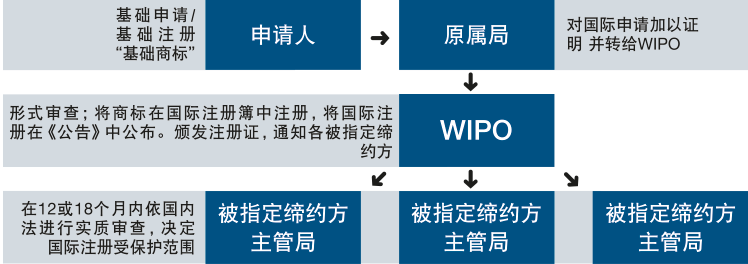Filing International Trademark Applications: The Process
1. Submit your application
You prepare your application and submit it to your Office of origin – the intellectual property (IP) Office of the Madrid System member where you have already applied for or registered your trademark (your “basic mark”). (Refer to ‘How to file’ for details on filing methods.)
Your Office of origin will:
- Check your international trademark application corresponds to the particulars of your basic mark.
- Certify your application.
- Forward it to WIPO.
2. Formal examination (WIPO)
We check that your international trademark application meets all formal requirements (full contact details, selection (designation) of at least one Madrid System member for protection, image quality, payment of fees, etc.).
- If it does not comply, we will send you and your Office of origin an ‘irregularity notice’ explaining how to correct the issue within a given time limit (typically three months). Sample irregularity notice [PDF]
- If or once it does comply, we will register your mark in the International Register, publish it in the WIPO Gazette of International Marks, send you a Certificate of international trademark registration confirming formal compliance, and notify the IP Offices of the members where you seek protection. Sample certificate of international trademark registration [PDF].
3. Substantive examination (IP Offices)
Possible outcomes of substantive examination by IP Offices
1. You receive no news within the 12 or 18-month limit. Protection is granted (tacit).
2. You receive a statement of grant of protection:
- If an Office finds no grounds for refusal, it must issue a statement of grant of protection of your mark. Sample Statement of Grant of Protection [PDF].
- If you designated Brazil or Cuba, you will receive a request to pay the second part of the individual fee at this stage. Sample Request for Second Part of Fee [PDF]
3. You receive a notification of provisional refusal:
- If an Office finds grounds for refusing protection of your mark (entirely or partially), it must send a provisional refusal notification to WIPO. We will forward it to you. The notification will include the reasons for the refusal, any further steps that are required (including the time limit to respond), review or appeal options, and whether or not you must appoint a local agent to assist you. Sample Notification of Provisional Refusal [PDF]
You can appeal against a provisional refusal at the domestic level.
Possible decisions after a provisional refusal
- Positive outcome –The Office grants protection of your mark for all or some of the goods and services listed in your international trademark registration. Sample Statement of Grant of Protection following a provisional refusal [PDF]
- Negative outcome – the Office confirms a total provisional refusal of your mark. Sample Confirmation of Total Provisional Refusal [PDF]
Tip! In some cases, you may be able to appeal this final decision with a higher judicial or administrative body, such as a Board of Appeals or Court. This will depend on the domestic laws of the Madrid System member in question. Find out more about domestic review and appeal procedures in our member profiles database.
The international trademark registration process at a glance

Find out more
- Video: The international application step-by-step (webinar recording)
- Guide to the Madrid System – Understand substantive requirements, how to deal with 'irregularities', the effects of an international trademark registration, responding to refusals issued by trademark offices, and more.
通过产权组织的马德里体系提交商标国际申请的流程分为五个基本步骤:
- 填报商标国际申请。请参考“怎样提交申请”。
- 向原属局提交申请。原属局将检查申请是否符合基础商标的细节。警告:请勿将申请发送给产权组织!原属局会对国际申请加以证明并将其发送给产权组织。
- 形式审查。产权组织检查商标国际申请是否符合所有形式要求(充分的联系信息、至少指定一个马德里体系成员、图像质量、缴费情况等)。 如不符合要求,产权组织将向申请人和申请人的原属局发出“不规范通知书”,解释如何在特定时限内(通常为三个月)补正。给予保护的说明示例
- 注册。产权组织在国际注册簿上登记商标,并在《产权组织国际商标公告》中公布,向申请人发送注册证——认可符合产权组织的形式要求——并通知被指定成员。注册证示例
。
- 实质审查。每个被指定成员的主管局都要进行实质审查。每个局都必须在规定时限内给予或拒绝保护,即自产权组织通知该局其被指定之日起12个月,或在某些情况下18个月。
提醒!由每个被指定马德里体系成员的国内法律决定商标国际注册的保护范围。
商标国际注册流程一览

- 了解实质性要求,怎样处理“不规范”,国际注册的效果,答复商标局发出的驳回,等等。
- 视频:国际申请逐步骤讲解(网络研讨会录像)
各主管局进行实质审查的可能结果
- 申请人在12个月或18个月的时限内没有收到任何通知。给予保护(默认)。
- 申请人收到一份给予保护的说明。如果主管局未发现任何驳回理由,则须发出对商标给予保护的说明。给予保护的说明示例
。
- 收到临时驳回通知。如果主管局发现有(全部或部分)驳回商标保护的理由,则须向产权组织发送一份临时驳回通知。产权组织会将此通知转发给申请人。通知中将说明驳回理由、需要采取的任何进一步措施(包括答复时限)、复审或上诉选项,以及是否必须指定当地代理人予以协助。临时驳回通知示例
申请人可以在国内层面对临时驳回提出上诉。
临时驳回后的可能决定
提示!某些情况下,申请人可以将此终局决定提交给上一级司法或行政机构,如上诉委员会或法院。这将取决于有关马德里体系成员的国内法。请使用产权组织的成员概况数据库进一步了解各成员复审和上诉的程序。